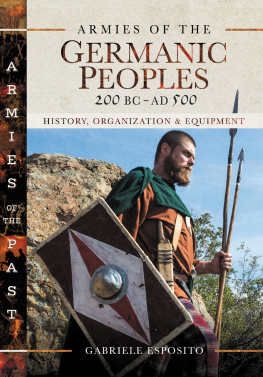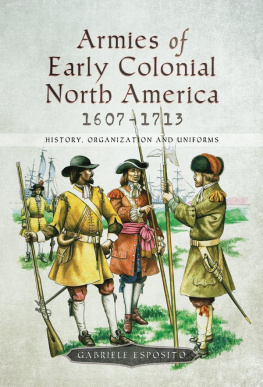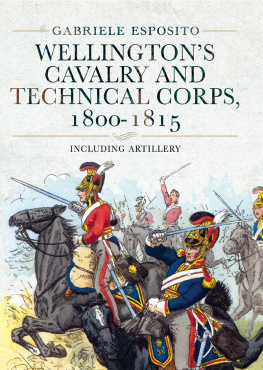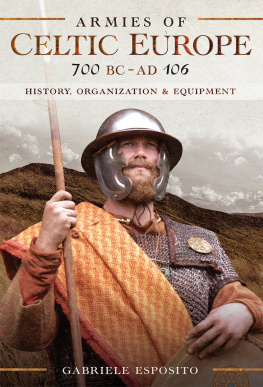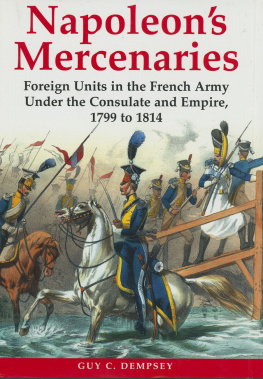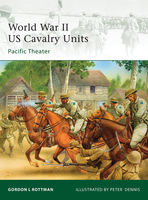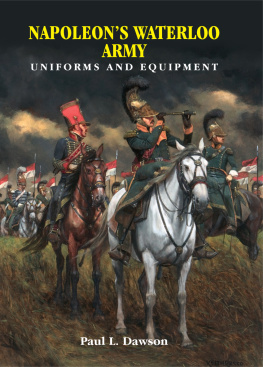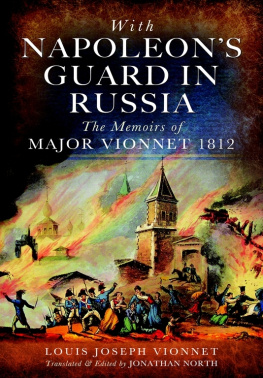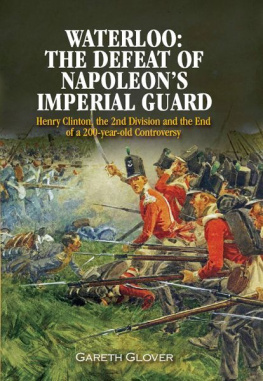Napoleons Imperial Guard
Napoleons Imperial Guard
Organization, Uniforms and Weapons
Gabriele Esposito
First published in Great Britain in 2021
by Pen & Sword Military
An imprint of Pen & Sword Books Limited
47 Church Street
Barnsley
South Yorkshire
S70 2AS
Copyright Gabriele Esposito 2021
ISBN 978 1 52678 671 5
eISBN 978 1 52678 672 2
Mobi ISBN 978 1 52678 673 9
The right of Gabriele Esposito to be identified as Author of this Work has been asserted by him in accordance with the Copyright, Designs and Patents Act 1988.
A CIP catalogue record for this book is available from the British Library
All rights reserved. No part of this book may be reproduced or transmitted in any form or by any means, electronic or mechanical including photocopying, recording or by any information storage and retrieval system, without permission from the Publisher in writing.
Pen & Sword Books Limited incorporates the imprints of Atlas, Archaeology, Aviation, Discovery, Family History, Fiction, History, Maritime, Military, Military Classics, Politics, Select, Transport, True Crime, Air World, Frontline Publishing, Leo Cooper, Remember When, Seaforth Publishing, The Praetorian Press, Wharncliffe Local History, Wharncliffe Transport, Wharncliffe True Crime and White Owl.
For a complete list of Pen & Sword titles please contact
PEN & SWORD BOOKS LIMITED
47 Church Street, Barnsley, South Yorkshire, S70 2AS, England
E-mail:
Website: www.pen-and-sword.co.uk
Gabriele Esposito is a military historian who works as a freelance author and researcher for some of the most important publishing houses in the military history sector. In particular, he is an expert specializing in uniformology: his interests and expertise range from the ancient civilizations to modern post-colonial conflicts. During recent years he has conducted and published several researches on the military history of the Latin American countries, with special attention on the War of the Triple Alliance and the War of the Pacific. He is among the leading experts on the military history of the Italian Wars of Unification and the Spanish Carlist Wars. His books and essays are published on a regular basis by Osprey Publishing, Winged Hussar Publishing and Libreria Editrice Goriziana; he is also the author of numerous military history articles appearing in specialized magazines like Ancient Warfare Magazine, Medieval Warfare Magazine, Classic Arms & Militaria Magazine, History of War, Guerres et Histoire, Focus Storia and Focus Storia Wars.
Acknowledgements
T his book is dedicated to my parents, Maria Rosaria and Benedetto, for all the great help that they give me during the creation of my books. A very special thanks goes to Philip Sidnell, my commissioning editor at Pen & Sword, for his precious support and advice.The quality of my books is the result of great teamwork, during which the production manager Matt Jones and the excellent Tony Walton play a crucial role. All the pictures published in this book are public domain ones obtained from the magnificent Digital Collections of the New York Public Library, in particular from the incredible Vinkhuijzen Collection of Military Uniforms. The vast contents of the latter can easily be browsed at: https://digitalcollections.nypl.org/collections/the-vinkhuijzen-collection-of-military-uniforms#/?tab=navigation .
Introduction
T he main aim of this book is to present a detailed overview of the history, organization and uniforms of Napoleons Imperial Guard. This elite corps was created in 1799 with the official denomination of Consular Guard, soon after Bonaparte became the First Consul of France. In 1804, with the proclamation of the French Empire, it assumed the new denomination with which it became famous, the Imperial Guard. During most of its history, the Imperial Guard of the French Army comprised three main echelons: the Old Guard, the Middle Guard and the Young Guard. The Old Guard was formed from veteran units that already existed before 1805 and whose soldiers had followed Napoleon since his first military campaigns of 1796/97. The Middle Guard was made up of younger veterans, who fought under Napoleon during the first victorious campaigns of the Empire (180509). The Young Guard comprised units that were organized after 1809 and whose members were young recruits; these were chosen from the annual intake of conscripts and volunteers who were recruited in the French Army. As we will see, these three main echelons included several units made up of foreign soldiers who served under Napoleon because of their sense of loyalty towards the emperor. In 1804, at its formation, the Imperial Guard comprised only some 8,000 soldiers; by 1812, at the beginning of the Russian campaign, it had ballooned to almost 100,000 soldiers and was an army corps comprising units from all the branches of service of the French Army. In many respects it was a true Praetorian corps, having many privileges, but it should be remembered that Bonapartes guardsmen always fought with great professionalism and courage when required to do so. The chapters of this book cover all the units that made up the Imperial Guard, from the most familiar contingents to the lesser-known corps.
Chapter 1
The Consular Guard
T he French Army had always comprised a very large Royal Guard, which was commonly known as the Maison du Roi, or Household of the King. This consisted of several different units, both on foot and mounted, which were charged with the protection of the French royal family. The Royal Guard had been greatly expanded at the end of the seventeenth century, during Louis XIVs long reign. The famous Sun King transformed his own Royal Guard into a sort of miniature army that was made up of several military corps. These could be merely ceremonial i.e. small units wearing picturesque old-fashioned uniforms and being of little practical use or larger combat corps that could be employed as elite troops during the military campaigns fought by the French Army. The French Royal Guard comprised the following units at the beginning of the eighteenth century:
Gardes de la Porte: a single company of fifty foot guardsmen, guarding the inside of the Royal Palace
Cent-Gardes Suisses: a single company of 100 Swiss foot guardsmen, guarding the Royal Rooms
Gardes de la Prevote: a single company of eighty foot guardsmen, charged with police duties inside the Royal Palace
Gardes de la Manche: twenty-five chosen guardsmen, who formed the inner bodyguard of the monarch
Gardes du Corps: four companies of mounted bodyguards, the first of which was made up of Scottish soldiers. Each company had 400 men
Compagnie des Gendarmes: one company of 200 heavy cavalrymen
Compagnie des Chevaux-Lgers: one company of 200 light cavalrymen
Mousquetaires du Roi: two companies of musketeers with 150 men each, known as Grey and Black from the colours of their horses
Grenadiers Cheval: one company with 250 horse grenadiers, chosen from the best grenadiers of the French Army



